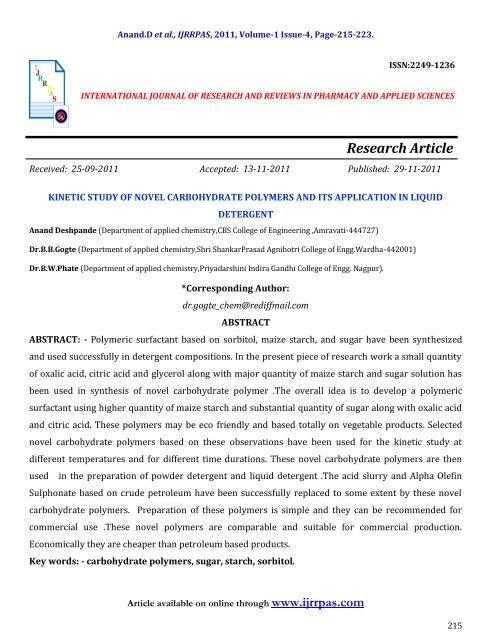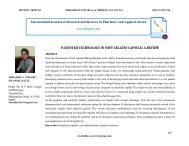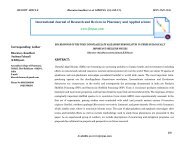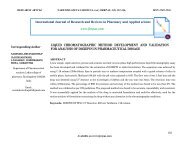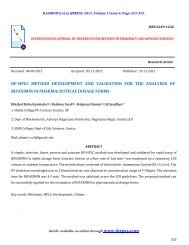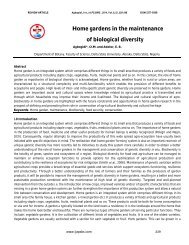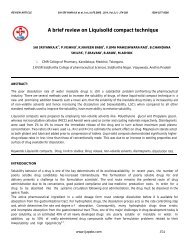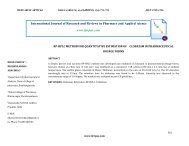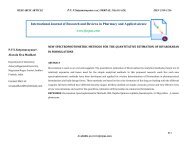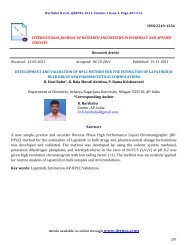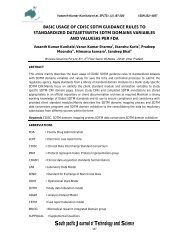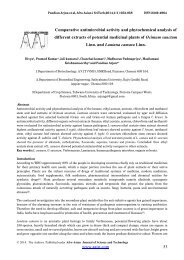KINETIC-STUDY-OF-NOVEL-CARBOHYDRATE-POLYMERS-AND-ITS-APPLICATION-IN-LIQUID-DETERGENT
KINETIC-STUDY-OF-NOVEL-CARBOHYDRATE-POLYMERS-AND-ITS-APPLICATION-IN-LIQUID-DETERGENT
KINETIC-STUDY-OF-NOVEL-CARBOHYDRATE-POLYMERS-AND-ITS-APPLICATION-IN-LIQUID-DETERGENT
Create successful ePaper yourself
Turn your PDF publications into a flip-book with our unique Google optimized e-Paper software.
Anand.D et al., IJRRPAS, 2011, Volume-1 Issue-4, Page-215-223.<br />
ISSN:2249-1236<br />
<strong>IN</strong>TERNATIONAL JOURNAL <strong>OF</strong> RESEARCH <strong>AND</strong> REVIEWS <strong>IN</strong> PHARMACY <strong>AND</strong> APPLIED SCIENCES<br />
Research Article<br />
Received: 25-09-2011 Accepted: 13-11-2011 Published: 29-11-2011<br />
<strong>K<strong>IN</strong>ETIC</strong> <strong>STUDY</strong> <strong>OF</strong> <strong>NOVEL</strong> <strong>CARBOHYDRATE</strong> <strong>POLYMERS</strong> <strong>AND</strong> <strong>ITS</strong> <strong>APPLICATION</strong> <strong>IN</strong> <strong>LIQUID</strong><br />
<strong>DETERGENT</strong><br />
Anand Deshpande (Department of applied chemistry,CBS College of Engineering ,Amravati-444727)<br />
Dr.B.B.Gogte (Department of applied chemistry,Shri ShankarPrasad Agnihotri College of Engg.Wardha-442001)<br />
Dr.B.W.Phate (Department of applied chemistry,Priyadarshini Indira Gandhi College of Engg. Nagpur).<br />
*Corresponding Author:<br />
dr.gogte_chem@rediffmail.com<br />
ABSTRACT<br />
ABSTRACT: - Polymeric surfactant based on sorbitol, maize starch, and sugar have been synthesized<br />
and used successfully in detergent compositions. In the present piece of research work a small quantity<br />
of oxalic acid, citric acid and glycerol along with major quantity of maize starch and sugar solution has<br />
been used in synthesis of novel carbohydrate polymer .The overall idea is to develop a polymeric<br />
surfactant using higher quantity of maize starch and substantial quantity of sugar along with oxalic acid<br />
and citric acid. These polymers may be eco friendly and based totally on vegetable products. Selected<br />
novel carbohydrate polymers based on these observations have been used for the kinetic study at<br />
different temperatures and for different time durations. These novel carbohydrate polymers are then<br />
used in the preparation of powder detergent and liquid detergent .The acid slurry and Alpha Olefin<br />
Sulphonate based on crude petroleum have been successfully replaced to some extent by these novel<br />
carbohydrate polymers. Preparation of these polymers is simple and they can be recommended for<br />
commercial use .These novel polymers are comparable and suitable for commercial production.<br />
Economically they are cheaper than petroleum based products.<br />
Key words: - carbohydrate polymers, sugar, starch, sorbitol.<br />
Article available on online through www.ijrrpas.com<br />
215
Anand.D et al., IJRRPAS, 2011, Volume-1 Issue-4, Page-215-223.<br />
<strong>IN</strong>TRODUCTION<br />
As globalization and increased world population is leading world towards extinction of non renewable<br />
source mainly petroleum. This scarcity can only be full filled by modifying renewable sources to such a level that it<br />
can match up in its properties, quality and other properties with non renewable source.<br />
Several industries like paint, detergents, inks and germicidal are mainly dependant on petroleum products, for<br />
example acrylic resin, various volatile organic solvents in paint industry. Alkyd resin one of the main ingredient of<br />
paint industry has 50% or more percentage of phthalic anhydride and maleic anhydride which are derived from<br />
petroleum origin. Organic solvents like toluene, xylene and benzene are petroleum origin and used in paint<br />
industry. Likewise linear Alkyl Benzene Sulphonate (LSBS) is used to a very large extent in detergent industry is<br />
also the example of use of petroleum products.<br />
The present generation of surfactants is based on Linear Alkyl Benzene Sulphonate or similar materials,<br />
which are obtain from crude petroleum. The price of crude petroleum is quite high; the stock of crude petroleum<br />
is soaring year after year. So we must develop renewable vegetative base alternatives for these conventional<br />
petroleum based surfactants.<br />
Every industry today is searching for alternative renewable resources of vegetable origin as the petroleum<br />
products are souring in price and availability. Thus biodegradable plastics, Eco- friendly surfactants and water<br />
thinnable paints are the key words in global search for alternative raw material.<br />
Objectives:<br />
The present work has following objectives,<br />
1. The basic idea of this research work is to obtain the optimize the ratio of LABS to carbohydrate based<br />
polymers, which will give the excellent technical performance. Thus we are trying to formulate Ecofriendly<br />
detergent based on renewable vegetable source like sorbitol, sugar starch, maleic anhydride, phthalic<br />
anhydride, which are having desired properties useful for products like liquid detergent.<br />
2. These polymers will be analyzed for various physicochemical properties such as % solid, HLB, Viscosity,<br />
Molecular weight, pH, Acid value etc.<br />
3. A combination of conventional active materials like Sodium Lauryl Sulphonate, Sodium lauryl ether sulphate,<br />
Alpha olefin Sulphonate, along with novel polymers has been used in a systematic manner to developed liquid<br />
detergents. In this way the present work is aimed at developing ecofriendly, cost effective and technically<br />
superior liquid detergents based on novel carbohydrate polymers.<br />
EXPERIMENTALS<br />
Synthesis of Novel Carbohydrate Polymers-<br />
The polymer based on carbohydrate dates back to as early as the 1930s. Reppe (1930) was the first to<br />
synthesize vinyl saccharide monomer. He synthesized ether from glucose and fructose by alkali catalyzed addition<br />
of protected sugars to acetylene.<br />
Article available on online through www.ijrrpas.com<br />
216
Anand.D et al., IJRRPAS, 2011, Volume-1 Issue-4, Page-215-223.<br />
The esters of carbohydrates are completely soluble in water and found to be suitable in the liquid<br />
detergent formulations .The detergent made out of acid slurry cause water pollution. Acid slurry has the<br />
petroleum origin. The detergents of petroleum origin are responsible for river foaming and eutrification .By using<br />
biodegradable polymers in detergent formulation the above mentioned problems of water pollution can be<br />
minimized to greater extent.<br />
The polymers containing carbohydrates are potentially process able and biodegradable and biocompatible<br />
polymers. The present research work encompasses the polymer synthesis from Sugar, starch, Sorbitol, maleic<br />
anhydride and phthalic anhydride using water as solvent. Sodium bisulphate and Sodium bisulphite used as<br />
catalyst in order to formulate the ecofriendly detergents.<br />
Surfactants can be produced from starch in combination with fatty acids and sugar. Products of these type<br />
have been known for as long as other “synthetic “ surfactants formed from petrochemical –derived material<br />
.There has been a recent trends towards surfactant based on renewable sources. This trends has been supported<br />
by several commercial plant opened by cognis (formally henkle) the driving force behind the trend is the number<br />
of benefit gained by starch based surfactants. Desirable properties of these surfactants in addition to being<br />
produced from renewable sources are that they are radily biodegradable they have low toxicity they are produced<br />
from and degrade into materials of low toxicity, they are mild on the eyes and skin and some can perform<br />
synergistically with other surfactants About 150000 tons of starch derived surfactants are produced annually<br />
worldwide. This novel carbohydrate polymer is cooked for different time period and at different temperature. On<br />
the basis of this kinetic study we can easily decide the cooking schedule for the preparation of novel carbohydrate<br />
polymer.<br />
RESULTS <strong>AND</strong> DISCUSSIONS<br />
Several experiments were performed to get desired polymer of low acid value, desired molecular weight,<br />
and pale color. Two polymers with desire characteristics are reported in table no. 1. .major ingredient was<br />
sorbitol (50-55%) and sugar solution has been used (28%). The higher proportion of sugar result in charring so<br />
the limit to which sugar can be tolerated is found to be 28-30%. A small amount of starch power (5-25%) has<br />
been used in composition B1and S1.<br />
A variety of catalyst have been used which include sodium bisulphite and sodium bisulphate. The<br />
preliminary physicochemical analysis is given in table no. 2 All the physicochemical analysis of both selected<br />
batches are registered after each hour. The acid values are quiet low in the range of 21-19 for B1 and 40-35for S1<br />
this indicate esterification reaction between acidic group of phthalic & maleic anhydride and OH group of starch,<br />
sorbitol, and sugar. Compounds giving OH groups are sorbitol, sugar, and starch while component phthalic<br />
anhydride and maleic anhydride gives acid groups. It is a esterification reaction the other possible chemical<br />
reaction is Etherification between two OH groups to give a epoxy group .All the samples are highly soluble in<br />
water, alcohol, and<br />
Article available on online through www.ijrrpas.com<br />
217
Anand.D et al., IJRRPAS, 2011, Volume-1 Issue-4, Page-215-223.<br />
Sodium hydroxide. The % solids for both the batches lies between 69 to 73.pHvalue for both lies between 3-5,HLB<br />
value is reasonably good for the preparation of detergent, molecular weight of the novel carbohydrate polymer is<br />
in the range of 3997-5179 which is determined by average molecular weight determination method. All these<br />
properties are recorded in the table no.2<br />
Table no.1:-Kinetic studies of two selected polymers based on Novel Carbohydrate Polymers<br />
Sr.No. Name of compounds Batch B1 Batch S1<br />
1 Sorbitol (70%) 55 51.8<br />
2 Maleic anhydride 5 4.71<br />
3 Phthalic anhydride 5 4.71<br />
4 Maize starch 25 4.71<br />
5 Oxalic acid 5 -<br />
6 Citric acid 5 -<br />
7 Glycerol - 2.83<br />
8 Sugar solution (80%) - 28.3<br />
Note: - Sodium bisulphate -1.5% and Sodium bisulphite -0.5% used as catalyst.<br />
Table no.2:-Physicochemical Analysis of novel Carbohydrate Polymer<br />
BATCH B1 After1hr After2hr After3hr After4hr After5hr<br />
%solid 70.19 71.54 72.89 73.30 69.40<br />
Acid value 21.87 21.19 20.17 20.26 19.20<br />
Viscosity(by ford cup no.4 at 30°c) 54 88 163 179 223<br />
Soluble in Water water water water Water<br />
PH. Value 4.99 4.95 4.91 4.89 4.31<br />
Molecular weight 4229.64 4179.45 3994.31 3996.24 4037.24<br />
H.L.B. ratio 14.8 14.7 15.0 15.3 15.6<br />
oxyrene oxygen value 1.94 1.83 2.00 2.03 2.08<br />
BATCH S1 After1hr After2hr After3hr After4hr After5hr<br />
%solid 69.94 71.49 72.89 73.39 72.44<br />
Acid value 40.19 39.11 35.17 37.62 35.25<br />
Viscosity(by ford cup no.4 at 30°c) 61 199 163 310 323<br />
Soluble in Water Water water Water Water<br />
PH. Value 4.71 4.70 4.91 4.42 3.35<br />
Molecular weight 4816.97 4512.49 3994.31 5163.26 5179.14<br />
H.L.B. ratio 13.1 13.3 15.0 13.9 14.2<br />
oxyrene oxygen value 12.78 12.83 11.00 13.84 13.12<br />
Five detergent samples have been prepared based on novel polymer S1 developed in the synthesis. The<br />
composition of formulated liquid detergent is given in table no.3.In this formulations acid slurry used is of 70%<br />
solid and is varied in the range 0-6 %, SLS (7.5%), SLES (10%) while the novel carbohydrate polymer used is of<br />
72% solids this polymer is varied from 3 to 15%<br />
Analysis of sample is given in table no. 4.<br />
Article available on online through www.ijrrpas.com<br />
218
Anand.D et al., IJRRPAS, 2011, Volume-1 Issue-4, Page-215-223.<br />
Polymer shows excellent foaming comparable to commercial sample as indicated in table no.4. The surface<br />
tension data also indicate significant lowering of surface tension in samples based on novel polymers. The results<br />
are comparable to commercial samples<br />
Table no 3:-Liquid Detergent based on Novel Carbohydrate polymers (Sample Selected after 4hrs.)<br />
SR.NO. <strong>IN</strong>GREDIENTS LD1 LD2 LD3 LD4 LD5<br />
1 Acid slurry (70%) 6.0 4.5 3.0 1.5 00<br />
2 AOS 6.0 4.5 3.0 1.5 00<br />
3 SLS 7.5 7.5 7.5 7.5 7.5<br />
4 SLES 10 10 10 10 10<br />
5 Sodium sulphate 05 05 05 05 05<br />
6 Urea 03 03 03 03 03<br />
7 Sorbitol (70%) 10 10 10 10 10<br />
8 Polymer (S1) (72%) 3.0 6.0 9.0 12 15<br />
9 Water 49.5 49.5 49.5 49.5 49.5<br />
Note: - Acid slurry and Sorbitol used are of 70% solids, while polymer (S1) is of 72% solids<br />
Table no 4:-Physicochemical properties of Liquid & Comm. Liquid Detergent<br />
CONC Samples Foam Volume in cm(time in min) density Surface<br />
tension<br />
% reduction in<br />
surface tension<br />
0.1% LD1 950 950 900 900 1.392 46.82 36.26<br />
LD2 650 650 600 600 1.364 46.63 34.42<br />
LD3 600 600 550 550 1.382 48.23 30.52<br />
LD4 500 450 400 400 1.392 47.59 26.18<br />
LD5 500 500 450 450 1.386 45.88 28.49<br />
CLD1 800 800 750 750 1.334 36.51 49.28<br />
CLD2 800 800 700 700 1.371 33.41 53.66<br />
0.25% LD1 850 850 800 800 1.361 44.95 39.24<br />
LD2 800 800 750 750 1.366 43.59 38.27<br />
LD3 700 700 650 650 1.359 45.24 35.29<br />
LD4 750 700 700 650 1.361 44.57 29.58<br />
LD5 700 600 600 550 1.373 42.33 31.51<br />
CLD1 850 850 800 800 1.346 33.62 52.65<br />
CLD2 850 850 850 850 1.333 30.29 54.17<br />
0.5% LD1 900 850 850 800 1.336 40.75 42.55<br />
LD2 750 750 700 700 1.359 41.65 43.29<br />
LD3 700 650 650 600 1.351 42.81 38.94<br />
LD4 600 550 500 500 1.364 40.64 33.65<br />
LD5 550 550 500 500 1.371 39.29 34.51<br />
CLD1 950 950 900 900 1.375 30.67 54.28<br />
CLD2 950 900 900 850 1.316 28.57 55.98<br />
1% LD1 950 950 900 900 1.329 38.23 44.36<br />
LD2 900 850 850 800 1.367 39.63 45.28<br />
LD3 700 650 650 600 1.372 40.58 46.39<br />
LD4 600 550 500 500 1.382 38.46 40.29<br />
LD5 550 500 500 450 1.377 37.38 39.54<br />
CLD1 1000 950 950 900 1.383 26.67 57.28<br />
CLD2 1000 950 950 900 1.334 26.33 58.03<br />
Article available on online through www.ijrrpas.com<br />
219
Anand.D et al., IJRRPAS, 2011, Volume-1 Issue-4, Page-215-223.<br />
Note: - CLD1 and CLD2 are commercial liquid detergent samples.<br />
CLD1 and CLD2 tested simultaneously. Detergency testing carried out on cotton, polyester and tricot cloth<br />
sample. The soil stain removing characteristics are recorded in table no. 5 The Tea Coffee and Spinach stain<br />
removing characteristics are given in table no.6, table no. 7 and table no. 8 simultaneously. In this liquid detergent<br />
sample LD3 and LD5 gives good results in comparison with the commercial liquid detergent available in the<br />
market.<br />
Table no.5:-Soil stain on Cotton, polyester and tericot sample<br />
R0= Reflectance measured on clean cotton cloth =100<br />
R0 =Reflectance measured on clean polyester cloth =100<br />
R0=Reflectance measured on clean Teri cot cloth =100<br />
Rs=Reflectance measured on Soil Stained cotton cloth =33<br />
Rs=Reflectance measured on Soil Stained polyester cloth =43<br />
Rs=Reflectance measured on Soil Stained Teri cot cloth =39<br />
Sr. no. Sample Conc.% Cotton Polyester Teri cot<br />
Rw Detergency Rw Detergency Rw Detergency<br />
1 LD1 0.1 66 49.25 67 42.10 70 50.81<br />
2 0.25 78 66.16 79 63.15 74 57.37<br />
3 0.5 72 58.20 74 54.38 71 52.45<br />
4 1.0 76 64.17 77 59.64 80 67.21<br />
1 LD2 0.1 68 52.23 69 45.61 66 44.26<br />
2 0.25 69 53.73 71 49.12 66 44.26<br />
3 0.5 79 68.65 78 61.40 80 67.21<br />
4 1.0 75 62.68 77 59.64 76 60.65<br />
1 LD3 0.1 86 79.10 88 78.94 85 75.40<br />
2 0.25 91 86.56 92 85.96 91 85.24<br />
3 0.5 94 91.04 96 92.98 94 90.16<br />
4 1.0 92 88.05 90 82.45 92 86.88<br />
1 LD4 0.1 65 47.76 68 43.85 68 47.50<br />
2 0.25 72 58.20 70 47.36 76 60.65<br />
3 0.5 85 77.61 86 75.43 85 75.40<br />
4 1.0 86 79.10 85 73.68 89 81.96<br />
1 LD5 0.1 69 53.73 72 50.87 72 54.09<br />
2 0.25 81 71.64 80 64.91 88 80.03<br />
3 0.5 86 79.10 88 78.94 87 78.63<br />
4 1.0 97 95.52 96 92.98 91 85.24<br />
1 CD1 0.1 86 75.43 88 80.32 86 79.10<br />
2 0.25 89 80.70 91 85.24 89 83.58<br />
3 0.5 91 84.21 93 88.52 91 86.56<br />
4 1.0 94 89.47 96 93.44 93 89.55<br />
1 CD2 0.1 82 68.42 80 67.21 78 67.16<br />
2 0.25 82 68.42 83 72.13 81 71.64<br />
3 0.5 85 73.68 86 77.04 83 74.62<br />
4 1.0 87 77.19 89 81.96 87 80.59<br />
Article available on online through www.ijrrpas.com<br />
220
Anand.D et al., IJRRPAS, 2011, Volume-1 Issue-4, Page-215-223.<br />
Table no. 6:-Tea stain on Cotton, polyester and tericot sample<br />
R0= Reflectance measured on clean cotton cloth =100<br />
R0 =Reflectance measured on clean polyester cloth =100<br />
R0=Reflectance measured on clean Teri cot cloth =100<br />
Rs=Reflectance measured on Tea cotton cloth =36<br />
Rs=Reflectance measured on Tea polyester cloth =29<br />
Rs=Reflectance measured on Tea Teri cot cloth =31<br />
Sr. no. Sample Conc.% Cotton Polyester Teri cot<br />
Rw Detergency Rw Detergency Rw Detergency<br />
1 LD1 0.1 84 75.00 84 77.46 81 72.46<br />
2 0.25 87 79.68 88 83.09 84 76.81<br />
3 0.5 89 82.81 90 85.91 87 81.15<br />
4 1.0 91 85.93 92 88.73 90 85.50<br />
1 LD2 0.1 82 71.87 82 74.64 80 71.01<br />
2 0.25 84 75.00 84 77.46 83 75.36<br />
3 0.5 86 78.12 85 78.87 85 78.26<br />
4 1.0 88 81.25 89 84.50 87 81.15<br />
1 LD3 0.1 85 76.56 89 84.50 87 81.15<br />
2 0.25 87 79.68 91 87.32 89 84.05<br />
3 0.5 90 84.37 93 90.14 91 86.95<br />
4 1.0 93 89.06 95 92.95 93 89.85<br />
1 LD4 0.1 87 79.68 85 78.87 81 72.46<br />
2 0.25 89 82.81 88 83.09 85 78.26<br />
3 0.5 90 84.37 90 85.91 88 85.50<br />
4 1.0 92 87.50 92 88.73 90 85.50<br />
1 LD5 0.1 90 84.37 88 83.09 87 81.15<br />
2 0.25 90 84.37 90 85.91 89 84.05<br />
3 0.5 91 85.93 92 88.73 90 85.50<br />
4 1.0 92 87.50 94 91.54 91 86.95<br />
1 CD1 0.1 80 71.83 82 72.46 84 75.00<br />
2 0.25 82 74.64 84 75.36 81 70.31<br />
3 0.5 84 77.45 86 78.26 79 67.18<br />
4 1.0 86 80.28 87 79.71 77 64.06<br />
1 CD2 0.1 77 67.65 79 68.11 81 70.31<br />
2 0.25 79 70.42 81 71.01 79 67.18<br />
3 0.5 81 73.23 83 73.91 77 64.06<br />
4 1.0 83 76.05 85 76.81 75 60.93<br />
Table no. 7:-Coffee stain on Cotton, polyester and tricot sample<br />
R0= Reflectance measured on clean cotton cloth =100<br />
R0 =Reflectance measured on clean polyester cloth =100<br />
R0=Reflectance measured on clean Teri cot cloth =100<br />
Article available on online through www.ijrrpas.com<br />
221
Anand.D et al., IJRRPAS, 2011, Volume-1 Issue-4, Page-215-223.<br />
Rs=Reflectance measured on Coffee cotton cloth =31<br />
Rs=Reflectance measured on Coffee polyester cloth =36<br />
Rs=Reflectance measured on Coffee Teri cot cloth =30<br />
Sr. no. Sample Conc.% Cotton Polyester Teri cot<br />
Rw Detergency Rw Detergency Rw Detergency<br />
1 LD1 0.1 82 73.91 84 75.00 88 82.85<br />
2 0.25 85 78.26 87 79.68 90 85.71<br />
3 0.5 87 81.15 89 81.25 92 88.57<br />
4 1.0 89 82.60 91 84.37 94 98.42<br />
1 LD2 0.1 85 78.26 85 76.56 82 74.28<br />
2 0.25 88 82.60 87 79.68 87 80.00<br />
3 0.5 90 84.05 88 81.25 89 84.28<br />
4 1.0 92 86.95 90 82.81 91 87.14<br />
1 LD3 0.1 84 76.81 85 76.56 84 77.14<br />
2 0.25 86 79.71 87 79.68 87 81.42<br />
3 0.5 90 84.05 90 82.81 88 82.85<br />
4 1.0 94 91.30 92 85.93 90 85.71<br />
1 LD4 0.1 81 72.46 87 79.68 87 80.00<br />
2 0.25 85 78.26 90 82.81 89 81.42<br />
3 0.5 88 82.60 92 85.93 90 85.71<br />
4 1.0 90 84.05 94 89.06 92 88.57<br />
1 LD5 0.1 87 81.15 88 81.25 84 77.14<br />
2 0.25 89 82.60 89 82.81 87 81.42<br />
3 0.5 91 85.50 91 84.37 89 84.28<br />
4 1.0 95 92.75 93 87.50 91 87.14<br />
1 CD1 0.1 89 82.81 91 87.14 87 79.71<br />
2 0.25 87 79.68 93 90.00 89 82.60<br />
3 0.5 85 76.56 95 92.85 91 85.80<br />
4 1.0 82 71.84 97 95.14 95 92.75<br />
1 CD2 0.1 82 71.87 84 77.14 84 75.36<br />
2 0.25 79 64.06 86 80.00 86 78.26<br />
3 0.5 77 64.06 88 82.85 88 81.15<br />
4 1.0 75 60.93 90 85.14 90 84.05<br />
Table no. 8:-Spinach stain on Cotton, polyester and tericot sample<br />
R0= Reflectance measured on clean cotton cloth =100<br />
R0 =Reflectance measured on clean polyester cloth =100<br />
R0=Reflectance measured on clean Teri cot cloth =100<br />
Rs=Reflectance measured on Spinach cotton cloth =38<br />
Rs=Reflectance measured on Spinach polyester cloth =32<br />
Rs=Reflectance measured on Spinach Teri cot cloth =41<br />
Article available on online through www.ijrrpas.com<br />
222
Anand.D et al., IJRRPAS, 2011, Volume-1 Issue-4, Page-215-223.<br />
Sr. no. Sample Conc.% Cotton Polyester Teri cot<br />
Rw Detergency Rw Detergency Rw Detergency<br />
1 LD1 0.1 82 70.96 88 82.35 85 74.52<br />
2 0.25 84 74.19 90 85.29 87 77.96<br />
3 0.5 89 82.25 92 88.23 90 83.05<br />
4 1.0 91 85.48 94 91.17 92 86.44<br />
1 LD2 0.1 84 74.19 85 77.94 81 67.79<br />
2 0.25 87 79.03 87 80.88 85 74.57<br />
3 0.5 91 85.48 89 83.82 87 77.96<br />
4 1.0 93 88.70 91 86.76 90 83.05<br />
1 LD3 0.1 89 82.25 85 77.94 88 79.66<br />
2 0.25 91 85.48 87 80.88 90 83.05<br />
3 0.5 93 88.70 90 85.29 91 84.74<br />
4 1.0 95 91.93 93 89.70 94 89.83<br />
1 LD4 0.1 90 83.87 87 80.88 84 72.88<br />
2 0.25 91 85.48 90 85.29 87 77.96<br />
3 0.5 94 90.32 92 88.23 89 81.35<br />
4 1.0 97 95.16 94 91.17 91 84.74<br />
1 LD5 0.1 81 69.35 82 73.52 77 61.01<br />
2 0.25 86 77.41 84 76.47 80 66.10<br />
3 0.5 88 80.64 85 77.94 83 71.18<br />
4 1.0 90 83.87 89 83.82 88 79.66<br />
1 CD1 0.1 85 77.94 84 72.88 89 82.85<br />
2 0.25 87 80.58 86 76.27 92 87.00<br />
3 0.5 89 83.82 88 79.66 94 90.32<br />
4 1.0 91 86.76 90 83.05 96 93.54<br />
1 CD2 0.1 81 72.005 79 64.40 84 74.19<br />
2 0.25 83 75.00 81 67.79 86 77.41<br />
3 0.5 84 76.47 83 71.18 88 80.64<br />
4 1.0 86 79.41 85 74.57 90 83.87<br />
REFERENCES<br />
1. 1 Chemistry and Technology of Surfactants by RichardJ.Farn (page no.14, 46)<br />
2. 2 http/www/google.com/polymeric surfactant/novel surfactants preparation, application and<br />
biodegradability.<br />
3. Bauby A., Leversidge P.,”Polymeric surfactant and their use industrial application”, U.S.A. 1995.<br />
4. http:/www/google.com/carbohydrate polymer/soyabeen, Fatty acid ester of Carbohydrate polymer.<br />
5. Gogte, B.B., Dontulwar J.R., BorikarD.K. Carbohydrate polymers 65, 2006, p.no. 207-210.<br />
6. .Bhatanagar M.S.,”Chemistry and Technology of polymers”, S.Chand &Company Ltd, 2004, p.no.1-28.<br />
7. Chattopadhya P.K.,”Modern Technology of soaps. Detergent and Toiletries, 2nd edition p. no.8-10.<br />
8. Gogte, B.B., Agrawal, RS. Journal of soaps, Detergents and Toiletries Rev., 34, 2003 p.no.25-28.<br />
9. Gogte, BB, Agrawal RS., Journal of soaps, Detergents and Toiletries Rev., 34,2003p.no. 19-22.<br />
Article available on online through www.ijrrpas.com<br />
223


